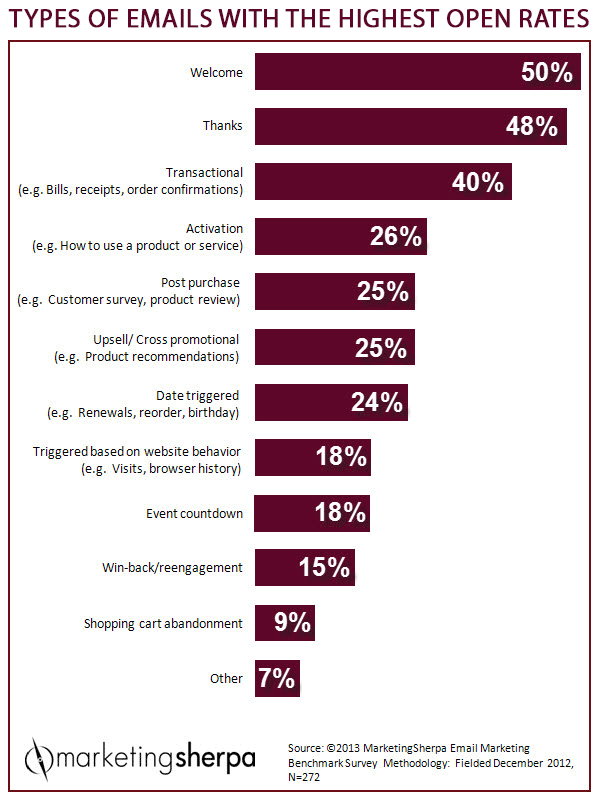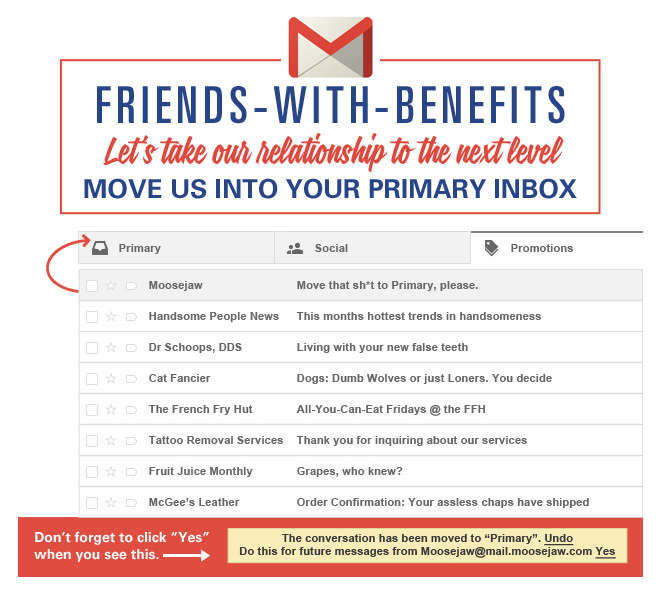In case you are wondering why I am dedicating an entire episode to the email welcome message, then you should open your ears to this statistic. The welcome message has the highest open rate of any type of email message. The average open rate of the welcome message is over 50%.

In addition to the lofty open rates, the welcome message has a click through rate of 5 times higher than all other promotional types of emails.

With that being said, first impressions also matter. For many, the email welcome message you send out is the first real interaction that someone will have with you. Optimizing your welcoming message can provide the positive first impression you need to encourage continued interaction with your site, blog, or brand.
Second chances in the world of email marketing are few and far between. You’ve got one opportunity to get this right. When it comes to email welcome message optimization, here are the methods you’ll want to use so that the initial connection you make with someone is a cornerstone that you can continue to build upon over time.
#1. Choose the right from line.
Super Office conducted a study and found that the sender name and subject line were the two clear triggers that led to an email being opened.

If you are branding yourself in your blog, then you want the welcome email to be from you. I actually did an A/B test comparing the open rates with the from line being Brandon Gaille or BrandonGaille.com. The from line with my name, Brandon Gaille, received 10% more opens than the domain name.
I have a quick trigger when it comes to deleting emails in my inbox. The from lines with a company name are usually the first to go.
#2. Create a compelling subject line.
The subject line is actually the most important part of any email that gets sent out. It needs to stand out in the inbox while being congruent with the body of the email message. If you are giving something away in exchange for their email, then that freebie needs to be the subject line.
For example, your subject line might be…
7 Ways to Dominate SEO [eBook]
A subject line tied to your personal story and accomplishment might be…
From Brain Tumor to 1 Million Visitors
The length of your subject line also plays a role in whether or not someone will open your email to see what is inside. Retention Science identified that subject lines that had between 6 and 10 words get opened the most.

#3. Let people know that they made the right choice.
There’s this idea that giving someone an email address is “free.” It’s not. An email address is personal information and it’s being offered in the format of a transaction. And, like with any sale that happens, there is a chance that the individual could experience “buyer’s regret.”
Maybe I shouldn’t have given that website my email address. Maybe I should unsubscribe right now so that I don’t get a bunch of spam.
Even when someone loves your brand, blog, or business, they may regret offering you their email address. This is why the best welcome messages reaffirm that the right choice was made.
Here’s how you can offer people warm, fuzzy feelings of joy instead of the cold feelings of regret.
- Make the message feel like a conversation. It may be an automated email, but welcoming someone should still feel genuine.
- Reinforce the idea of community. It’s important to be humble, but it is equally important to offer value. Show in your welcoming email that this new person has joined an established community that offers many ways to find value.
- Create a safety net. We all must be protective of our personal information these days. You never know when an identify thief might strike. Make sure you let people know that their information is safe with you.
You can do everything right here and still have people unsubscribe due to buyer’s regret. What you’re doing by following this method is limiting the damage you may experience.
#4. Make sure that everyone understands you are a real person.
It’s hard enough to send someone you don’t know an email address. It becomes even more difficult if the welcoming email received in return doesn’t contain any personal information. Of course we live in a world where many things are automated, but transactions of any type still require a personal touch to be consistently successful.
For this reason, it is a good idea to make sure that a real name is included somewhere within your welcoming email. This will make the new subscriber feel better about their decision to offer an email address because you’ve offered that needed personal touch.
Whenever possible, it is also a good idea to send this email out in real time so there isn’t a delay in its reception.
Delay often equates to deletion.
#5. Don’t offer a bait and switch.
The emotions of your welcoming email should be authentic. Offer gratitude because you are grateful for the transaction. Then make sure that you’re actually delivering the content you promised to the new subscriber.
To optimize your email welcome message, you’ll need to carefully test all of the information that is included in the message.
- Test all of your hyperlinks within the welcome email to make sure they actually work and deliver the new subscriber to the intended destination.
- Make sure all of your downloads are accessible from the email, either as an attachment or to a specific landing page. If it’s a landing page, make sure the downloading process there works as well.
- Ensure that any logins, membership trials, or other brand interactions work as promised.
Even if the roadblocks are unintentional, a new subscriber is likely to be less than impressed if they can’t obtain the valuable items they were promised. From their perspective, you’re not living up to the deal.
#6. Let new subscribers know what the future will hold.
Show the new subscriber what the future holds for them if they choose to remain on your email marketing list. This is your chance to revisit the value proposition that was offered and reinforce the decision in the new subscriber’s mind about why they completed the transaction in the first place.
There are some specific details about the future that you should consider including to make sure the welcome message has been optimized.
- Include details about the type of content, the service, or the product the new subscriber will receive. This will allow that person to watch their email inbox for the promised items when you send them.
- Mention how often you’ll be sending out emails. If you have an entire welcoming series that covers 10 emails in 10 days, then let people know this. That way there aren’t any frustrating surprises in their email that could cause them to unsubscribe.
- Review the expertise you’re able to share. People see value in expertise. This is why we all choose the brands, products, and services that we use. We want the very best. Make sure you tell new subscribers why you’re the best and what that will mean to them in the coming days.
By following these steps in the welcoming message, you’ll be able to optimize the marketing potential of every new subscriber.
#7. Confront the issue of spam right away.
Email marketers can hit every method perfectly for a great welcome email, only to find that their follow-up email winds up getting filtered into a spam folder. You could rely on your autoresponder or email provider to use spam checking tools to prevent this from happening. You could also just make an attempt to solve this problem in your initial email.
Reserve a portion of this email to let your new subscriber know they can mark your email address as a “safe address.” This will help it to avoid being marked as spam. It also increases the chances that your future emails are going to be opened.
Depending upon how often you send out emails and which email marketing company you use, Gmail may send your welcome message straight to the promotions tab. Since Gmail accounts for 40-50% of all email signups, it is important to let your new subscribers know what to do in the thank you page after they sign up. The best practice is to show them a screenshot of where the promotions tab is, and how to tell Gmail that you want to receive future emails directly to the inbox.

I have helped some of my clients double their yearly revenue just by adding these simple gmail instructions to their thank you pages.
#8. Be authentic with your story.
Your welcome message is the first real introduction a new subscriber receives. This means you must be authentic with your story if you’re going to attract their attention. There are a number of ways that you can show off your personality as you tell your story, but two primary methods tend to work the best.
- Address a problem that the new subscriber likely has. There’s a reason why someone gave you their email address. If you can find a unique solution that works, the value you’re able to offer is going to skyrocket.
- Tell your story. There’s a path you followed to get to where you are today. Tell the story of that journey and your subscribers will instantly feel a connection with you.
Authenticity trumps errors. It builds loyalty. It creates relationships.
#9. Use a link to your blog’s Start Here page to keep your links to a minimum.
Nothing makes me hit delete faster than a welcome email that is loaded with links. An effective Start Here page will have the links to everything you are selling, your best posts, and even your top earning affiliates. This allows you to have one link to a page that will walk your new subscribers through everything you want them to see.
If you do not have a Start Here page, then you have to read my post on the 12 Vital Items to Include on Your Start Here Page.
#10. Add an unexpected bonus to over fulfill their expectations.
By giving them an extra bonus, you will make your new subscribers feel psychologically in debt to you. This is going to lead them to opening your future emails and buying what you have to offer.
#11. Give your welcome email a personal sign-off.
If you fail to sign off a welcome email using a personal sign-off, then all of your optimization efforts are going to be for nothing.
You want to be able to leave your new subscriber on a positive note. You want them to be looking forward to the next email you’re planning to send them.
You will want to make sure that your personal sign-off matches the rest of the email’s tone and voice so that the final impression is one of consistency. If you’ve been friendly and warm, then stay that way. If you’re email has been funny, then be funny.
#12. Now you’re ready to add the post-script.
The post-script is your way to be like Columbo and add just one more thought. There are four ways you can approach this additional thought.
- Use a call to action. This post-script addition makes sense if you have another step that you want your new subscriber to take. If you’ve given them a log-in to access a trial membership, then your call to action could be to encourage them to “start their trial today.”
- Install an open loop. This option allows you to give the new subscriber a preview of what they’re going to find in the next email.
- Ask to follow you on your top social media channel. Do not use the shotgun approach and list out all of your social media links. Choose one.
- Link to your favorite affiliate product or service. This is a great way to add some more revenue while providing additional value to the new subscriber.
The post-script should be a single sentence. Do not overdo it.
#13. Make sure your reply email goes to your real email address.
Many of the people that get your welcome email are going to reply directly to it. Most of the replies that I have received are thank you messages and people sharing their own story with me. However, I get several emails every month asking me about my products and services. These questions lead to phone calls, which lead to new clients.
#14. End your welcome message by asking a question.
Once you make sure that you are receiving all of the replies, then you may want to add a question to the end of your message. A simple question can turn your welcome message into an engagement and sales machine.
For example, I like to ask the following question at the end of my welcome message…
I have a quick question for you. What is the url of your blog so that I can take a quick look at what you are writing about? Please take a moment to reply to this email and send me the link to your blog.
This question opens up a line of two way communication between myself and my audience. I am able to give each person that replies some quick pointers, and I am also able to qualify them as a potential client or student for my paid course. After I review their blog and give quality feedback, I offer them a free consultation or direct access to one of my webinars tied to my course.
#15. Add some personality to your signature.
The email signature is the last section of your welcome message, and it is often the most neglected. I reviewed over fifty welcome messages while doing the research for this episode. Forty signatures had only a simple signature with no picture. Out of the remaining 13 that had pictures, they were all a typical boring profile picture.
I highly recommend to include a picture of yourself doing something unique, which says something about your personality. A few good examples are..
The Fun Family Picture – Almost everyone that is reading your email has a family or is part of a family. Showing a picture of your family will actually creates a higher level of perceived trust. People tend to trust other people with family values than those that come across as a lone wolf. I use a picture of my family dressed up as Star Wars characters for Halloween. Instead of ending the email with “Thank you.” I use “May the Force Be With You.”

You and Your Pet – A big portion of your audience is also going to have a cat or a dog. This is a great substitute for the family picture.
You and Your Blog Topic – If you are a food blogger, then you should probably have a picture of you in front of one of your favorite recipes. Whatever your topic is, try and take a picture of you with it or in it.
No matter what, even if it is just your smiling face, you should always include a picture in the closing signature of your welcome message.
The bottom line is that your welcome email is the most important email that you will ever send out to your subscribers. It will get the most opens and clicks. It will build trust, and it will lay the foundation for turning your subscribers into paying customers.
As Will Rogers famously said…

Watch Today’s Masterclass Webinar, “How I Got to 1 Million Monthly Visitors,” to Bypass the Waitlist for my Exclusive Course & Get Two Bonuses Worth Over $5000
 [mc4wp_form id=”43544″]
[mc4wp_form id=”43544″]

Although millions of people visit Brandon's blog each month, his path to success was not easy. Go here to read his incredible story, "From Disabled and $500k in Debt to a Pro Blogger with 5 Million Monthly Visitors." If you want to send Brandon a quick message, then visit his contact page here.

